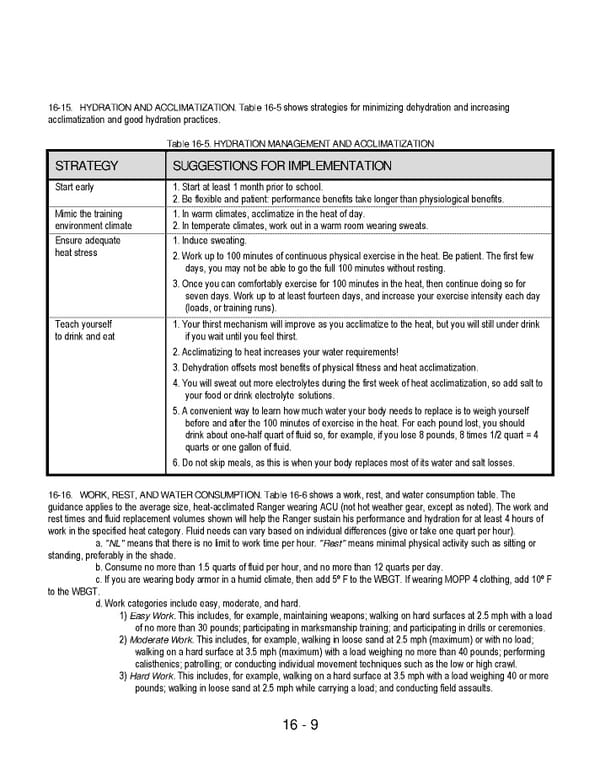16 - 9 16-15. HYDRATION AND ACCLIMATIZATION. Table 16-5 shows strategies for minimizing dehydration and increasing acclimatization and good hydration practices. Table 16-5. HYDRATION MANAGEMENT AND ACCLIMATIZATION STRATEGY SUGGESTIONS FOR IMPLEMENTATION Start early 1. Start at least 1 month prior to school. 2. Be flexible and patient: performance benefits take longer than physiological benefits. Mimic the training environment climate 1. In warm climates, acclimatize in the heat of day. 2. In temperate climates, work out in a warm room wearing sweats. Ensure adequate heat stress 1. Induce sweating. 2. Work up to 100 minutes of continuous physical exercise in the heat. Be patient. The first few days, you may not be able to go the full 100 minutes without resting. 3. Once you can comfortably exercise for 100 minutes in the heat, then continue doing so for seven days. Work up to at least fourteen days, and increase your exercise intensity each day (loads, or training runs). Teach yourself to drink and eat 1. Your thirst mechanism will improve as you acclimatize to the heat, but you will still under drink if you wait until you feel thirst. 2. Acclimatizing to heat increases your water requirements! 3. Dehydration offsets most benefits of physical fitness and heat acclimatization. 4. You will sweat out more electrolytes during the first week of heat acclimatization, so add salt to your food or drink electrolyte solutions. 5. A convenient way to learn how much water your body needs to replace is to weigh yourself before and after the 100 minutes of exercise in the heat. For each pound lost, you should drink about one-half quart of fluid so, for example, if you lose 8 pounds, 8 times 1/2 quart = 4 quarts or one gallon of fluid. 6. Do not skip meals, as this is when your body replaces most of its water and salt losses. 16-16. WORK, REST, AND WATER CONSUMPTION. Table 16-6 shows a work, rest, and water consumption table. The guidance applies to the average size, heat-acclimated Ranger wearing ACU (not hot weather gear, except as noted). The work and rest times and fluid replacement volumes shown will help the Ranger sustain his performance and hydration for at least 4 hours of work in the specified heat category. Fluid needs can vary based on individual differences (give or take one quart per hour). a. "NL" means that there is no limit to work time per hour. "Rest" means minimal physical activity such as sitting or standing, preferably in the shade. b. Consume no more than 1.5 quarts of fluid per hour, and no more than 12 quarts per day. c. If you are wearing body armor in a humid climate, then add 5º F to the WBGT. If wearing MOPP 4 clothing, add 10º F to the WBGT. d. Work categories include easy, moderate, and hard. 1) Easy Work. This includes, for example, maintaining weapons; walking on hard surfaces at 2.5 mph with a load of no more than 30 pounds; participating in marksmanship training; and participating in drills or ceremonies. 2) Moderate Work. This includes, for example, walking in loose sand at 2.5 mph (maximum) or with no load; walking on a hard surface at 3.5 mph (maximum) with a load weighing no more than 40 pounds; performing calisthenics; patrolling; or conducting individual movement techniques such as the low or high crawl. 3) Hard Work. This includes, for example, walking on a hard surface at 3.5 mph with a load weighing 40 or more pounds; walking in loose sand at 2.5 mph while carrying a load; and conducting field assaults.
 Ranger Handbook Page 304 Page 306
Ranger Handbook Page 304 Page 306